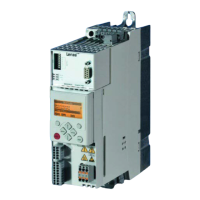8400 StateLine C | Reference manual
Commissioning
Commissioning of the "Switch-off positioning" technology application
62 L Firmware ≤ 11.00 - DMS 8.0 EN - 10/2011
Functional principle of a switch-off positioning without pre-switch off
In case of the switch-off positioning without
pre-switch off shown above, it makes sense
to use the "Terminals 2
" control mode:
1. Set DI3 to HIGH level to activate CW rotation.
2. The drive accelerates along the acceleration ramp (C00012
) up to the traversing speed
set in C00039/2
.
3. After reaching the DI1 contact, the drive comes to a stop with quick stop (QSP) in the
target position.
4. Reset DI3 to LOW level and set DI4 to HIGH level to activate CCW rotation now.
5. The drive is accelerated along the acceleration ramp (C00012
) up to the traversing
speed set in C00039/2
.
6. After reaching the DI2 contact, the drive comes to a stop in the initial position with
quick stop (QSP).
Tip!
• In order to avoid positioning inaccuracy due to signal propagation delays, the
initiators can be directly evaluated by the drive controller. Limit switch
evaluation can be configured in the drive controller. In code C00488/x
you can
change the method of detecting position signals from level evaluation to edge
evaluation.
• In order to prevent unintended movements of the load in the target position,
the use of a holding brake is recommended as an alternative to DC-injection
braking (limited torque).
• The device terminals and their function assignment do not appear in the FB
Editor. The assignment of (hardware) terminals to (software) functions is
explained in the chapter "Terminal assignment of the control modes
". ( 329)
Commissioning steps
As shown in illustration [3-2]
, below find a description of the commissioning steps of the
"Switch-off positioning" application without
pre-switch off.
Please observe the sequence of the steps in the following chapters and follow them
through carefully. This will help you to commission your controller quickly and as safely as
possible:
Prepare controller for commissioning
( 63)
Creating an »Engineer« project and going online
( 64)
Parameterising the motor control
( 65)
Parameterising the application
( 66)
Saving parameter settings safe against mains failure
( 68)
Enable controller and test application
( 68)

